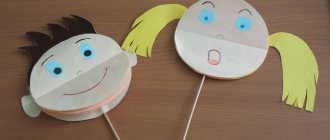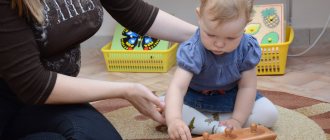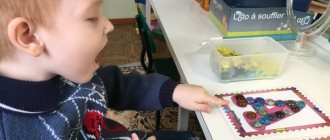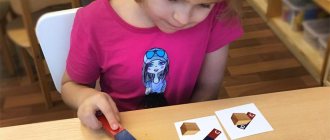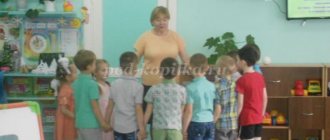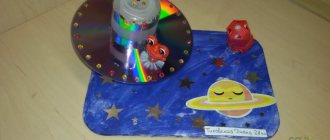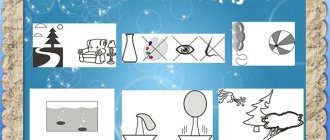You need to teach something when a question arises. Children are sent to kindergarten at the age of three. By this time, it is useful to teach your child the names of the days of the week. If the baby distinguishes Monday from Friday, it will be easier for him to get used to it. He will know when the long-awaited weekend comes. The very concept of a weekend arises only after entering kindergarten. It is easier for a child to integrate into the seven-day rhythm of adults and socialize. So by this time, parents need to know how to teach their child the days of the week.
If a preschooler is raised at home, the problem of learning is not so acute. You can wait until the baby himself asks: “Why was daddy at home yesterday and left today?” Such a question will not arise later than 4-5 years, the age of why. But by the age of 5-6, a preschooler should know the names of the days of the week, relate them to life, that is, understand that today is Wednesday.
What you need to know to learn the days of the week
- The child must be able to count to 10.
- The baby must understand what “day” and “night” are, that after night comes the next day.
- Abstract thinking must develop so much that the child can separate yesterday, today and tomorrow. Usually every adult's memories contain the moment of this realization. If a baby wakes up on a dark winter evening and says “yesterday” about morning time, then parents should think about how to teach their child the days of the week.
Creative tasks for remembering the days of the week
For creative parents who like to make things with their children, the following ideas are suitable:
"Locomotive"
We cut out a steam locomotive and carriages from paper, there should be seven carriages. Each carriage is a day of the week. You will also need a figurine of your child's favorite hero. Move the figurine from carriage to carriage depending on the day of the week.
"Drawn Stories"
Take whatman paper and glue seven pockets of different colors, which will indicate the days of the week. You can cut out pictures of children’s actions from magazines, or draw them yourself and distribute them into pockets. The child will check the contents of his pockets every morning and know what he will do today.
"Seven-flowered flower"
You can make a flower with tear-off petals, or ones that can be detached and reattached. It is important to discuss with your child what day of the week it is and what you have planned for today.
"Watch"
Make a dial (clock base) from cardboard or a disposable plate, divide the base into seven parts. You can color each part with a certain color and write the day of the week. Cut out an arrow from cardboard and attach it with a button. The clock for determining the day of the week is ready!
You can buy a tear-off or wall calendar and invite your child to move the slider himself.
Where to begin
- Reinforce the concepts of day, night, yesterday, today, tomorrow . To do this, start asking questions before going to bed: “What interesting happened today? What discoveries will we make tomorrow? And in the morning, on the contrary, ask: “What did you eat before going to bed yesterday?” Focus on pleasant events that happened yesterday or will happen tomorrow.
- Enter the concepts of the day before yesterday and the day after tomorrow . The child must realize that he needs to jump over the day. Use new words only together with familiar ones: tomorrow and yesterday, day and night. Say: “Tomorrow it will be cold, and the day after tomorrow it will be warm again.”
- Some advanced parents use such rarely used words as the day before yesterday and the day after tomorrow. But the majority will still say “in three days.”
How to explain to a child what a week is?
So, your child counts to 10, doesn’t confuse tomorrow and yesterday, and knows what a day is. We can get to the heart of the matter.
To form the concept of “week” in your child, invite him to choose a different color for each day. You can cut circles out of colored paper. Put aside a circle every day, and when 7 circles have accumulated, tell your child that 7 days is a week.
It is better to study the names of the days of the week by linking them to events that happen to the child on a weekly basis. For example, “on Tuesday and Thursday you go to a dance club,” “on Saturday we visit your grandmother,” etc. It will be good if you select similar associations for each day of the week.
You can also continue to study the days of the week using multi-colored circles, assigning each day a different color.
Usually children quickly understand that when they are not in kindergarten and their parents are at home, this is the weekend. For clarity, you can use your fingers: 5 fingers of one hand - 5 working days, two fingers of the other hand - 2 weekends.
How to teach your child the days of the week
- Divide your days into weekdays and weekends. Wait for the question and identify the problem. For example, you send your child to kindergarten, and he asks how many days he needs to go. It is necessary to explain that there are seven days in a week: 5 working days, 2 days off. Just don't be too categorical. There are children who believe that a day off is a law of nature, no one goes to work, and salespeople, teachers, and other working adults are very similar robots. It would be correct to explain that Saturday and Sunday are days off for many, but doctors and firefighters work.
- Learn names in a playful way, as described below.
- You can tell a sensible child about the meanings of the days of the week. After the week (Sunday in Old Russian), Monday began. That is, during the week (Sunday) we didn’t do any work and rested. Second in line is Tuesday. The next day is in the middle. Thursday and Friday from the numbers. Saturday - in the language of the Bible, rest, rest. The child does not need to know the details. If children go to the Orthodox Church, tell them that in Rus' the week (or week in the church) began on Sunday, which, in turn, began to be celebrated on Saturday evening. That is, Saturday was the seventh, holiday day.
- An educational cartoon is suitable for busy (uncreative) parents. For example, “Tralik and Roller”, “Locomotive Chukh-Chukh”. But parents are not involved in teaching, which is bad. Therefore, it is better to watch cartoons with your child, comment on it, and then discuss the plot.
- Even if you don’t make any special efforts, but just name the day of the week every morning, your baby will be able to quickly remember everything.
Exercises to remember the days of the week
Exercises also promote good memory. True, these tasks are designed more for children of older preschool age.
1. Crossword. You can find a crossword with answers to the question, or you can find a graphic one.
2. The association number = day helps well to remember, respectively: 1 - Monday; 2 - Tuesday, etc. Once the association is formed, you can perform similar matching exercises.
3. Exercise “I believe - I don’t believe.” An adult says some fact, for example, “Tuesday comes after Sunday.” If the child does not agree with this fact, he must name the correct answer.
4. Solving puzzles, puzzles and riddles.
For example:
The slacker put things off from Wednesday to... (Monday)
5. Ask casually what day of the week it is, how many days until the weekend.
6. List the days of the week in correct and reverse order.
Visual aids and games for learning the days of the week
- Regular wall calendar. Names must be written in full and in capital letters. This way, even the smallest child will remember how to write such complex words. This is also suitable for a child who does not know letters (there is a way to teach reading whole words).
- A seven-flowered flower that you can draw, decorate and name each petal a day of the week.
- Seven dwarves or seven heroes (depending on which fairy tale you are raising your child on). You can take a picture from a book or a coloring book and sign the day of the week for each gnome or hero.
- Toys consisting of segments. Methodists recommend taking a train with seven carriages of different colors, each named: Monday, Tuesday…. A train can play the role of a calendar: in the morning, move your favorite toy to another carriage. Ask questions: “Show everyday life; find Saturday; What color is Thursday?
- The role of a homemade weekly calendar can be played by anything, for example, seven vases or seven dolls. It is better if there are girl dolls and boy dolls, because there are men's and women's days, and Sunday is neuter, it can be designated by a doll. Think about how you will depict the days of the week. For example, you can put a red riding hood on the doll whose day it is, put a toy pie in front of it, etc.
- Make a clock that shows the day of the week. Make a cardboard clock, divide it into 7 segments and attach a movable hand. This design will help you learn to use the clock more easily in the future, just write the words clockwise.
- Together with your child, make colorful drawings that symbolize the seven days of the week, for example, a rainbow, a flower, pencils in a box, trailers, houses. Each day has its own color.
- Read or learn poems about the days of the week by Mikhalkov, Stepanov, Usachev and other children's authors, proverbs and sayings. Use poetry at the stage of consolidating the material. For example, this poem.
One two three four five. Let's call it weekdays. Monday is the first day, It is the beginning of all weeks. Tuesday is the second day, it is always before Wednesday. In the middle is Wednesday, always smiling. And the fourth day is Thursday, there is a lot to do, right up to the top. The fifth Friday is coming, it leads to the weekend. Day six is Saturday – We don’t go to work. Sunday - the seventh day - Either lie down or sing a song. Count the days of the week and start over.
- Rhyme the days of the week with other words to create a vivid image: Monday - slacker, Sunday - salvation, Saturday - care...
- Associate the day of the week with an activity or omen that is different from the activities and omen on other days. For example, on Monday we buy groceries for the week, on Tuesday we play the piano, on Saturday we can go to bed after 9 o’clock, on Sunday we watch cartoons.
The days of the week can be learned easily and with pleasure by communicating, imagining and playing. Do not cultivate prejudices in children, then they will grow up happy. Don't tell them that Monday is hard and Sunday goes by very quickly. Teach your children to enjoy every day.
Games to help you remember the days of the week
You can remember difficult things through games. And the child will have fun, and you will be able to pass on useful knowledge to him, and you will spend time together, which is important for the baby.
"Catch the Ball"
You throw a ball to your child and name the objects (table, apple, sock), and he must return the ball back to you. But when the child hears the name of the day of the week, his task is to raise the ball above his head with the words “I caught Tuesday.” To win you need to collect the entire week.
"Guess it"
An adult describes the day of the week in all sorts of ways, for example: “this day comes after Wednesday,” “on this day we go to the pool,” etc. The child’s task is to correctly name the hidden day.
"Nimble Palms"
The child should clap when he hears the name of the day of the week. An adult can be cunning by pronouncing similar-sounding words wind, second, echo, Tuesday...
"Picture"
The adult reads out the actions, and the child shows how it happened.
For example, “on Monday I played football” (the child depicts playing football), “and on Tuesday I wiped the floor” (the child shows), “on Wednesday I gnawed an apple,” etc.
It will be more fun to perform movements to rhythmic music, speeding up the tempo.
We study the days of the week, educational and methodological material on speech development (middle group) on the topic
LEARNING THE DAYS OF THE WEEK
Explain to your child that there are 7 days in a week (Monday, Tuesday, Wednesday, Thursday, Friday, Saturday, Sunday). The first five days are working days, on these days adults work, children go to kindergarten or go to school. The last two days (Saturday and Sunday) are weekends, on these days all people rest.
Next, move on to the concepts of “today”, “tomorrow”, “yesterday”. Explain these words to your child using a specific example, for example, what he is doing today, tell him what you will do tomorrow, remember with him what you did yesterday.
• Why do you need to learn the days of the week?
Once children start school, every day becomes more organized for them. This is noticeable not only at school, but also at home. It is very important for children to know what day it is and what will happen on that day. Perhaps they have a book that needs to be donated to the library, or it's a friend's birthday. From the very first time a child asks what day it is, parents should encourage this interest. Children must learn to be independent in managing their time. Knowing what day it is today, the child will take the first steps towards planning his time and schedule, which in turn fosters composure and organization.
• When should you teach the days of the week?
The names of the days of the week can be used from a very early age. Children will hear the names of the days of the week and although they will not understand them yet, they will begin to assimilate this information and get used to it.
Pay more attention to days that are important for your family: Birthdays, celebrations, visits of grandparents, weekends, etc. Like many things, this training can be easily integrated into daily family conversations.
• Ways to teach the days of the week
There are many ways to help you learn the days of the week. Here are just a few tips: You can make a simple calendar with the days of the week and hang it in a visible and easily accessible place. In any case, you can refer to this calendar to find out what day it is today, what day it was yesterday and what will happen tomorrow. To diversify and enliven this calendar, you can write next to each day important events that happen every day on that day.
There are rhymes that will help you learn the days of the week. Regular repetition of these rhymes will eventually establish the order of days in children's minds. Don't worry if children confuse the days of the week. The concept of time is an abstract concept for young children and takes time to remember and learn. Talking about family plans and creating simple charts that reflect future events will bring order and more meaning to the concept of “days of the week.”
• Regular repetition.
Don't expect learning the days of the week to be a quick process. At first, the child will confuse the order of the days. But with regular practice and repetition, things will eventually fall into place.
• Introducing the child to the days of the week
Introduce your child to the days of the week. You can try to sing the names of the days of the week in a row to some suitable tune. Pin a table with the names of the days of the week on the wall in the children's room and every time you hug your child out of bed in the morning, show him what day it is. You can also make a kind of dial with the names of the days of the week, and then the baby will be able to move the hand to the desired day himself.
Draw your child's attention to the fact that some events in his life are repeated on certain days: going to the pool, dancing, grandma's arrival, etc. When he has learned the days of the week well, introduce him to the names of the months.
Hang a calendar in the children's room and cross out the previous day with your child every evening. Remind him what month and day it is and show him where it is on the calendar. Let the child cross out the date himself, even if he doesn’t know the numbers yet (by the way, this is a good prelude to becoming familiar with the numbers indicated)
POEMS ABOUT THE DAYS OF THE WEEK
Bear looked into the fragrant spruce forest on Monday morning. This day He helped the ant build a house. And on Tuesday it was raining, Bear came to the wolf, We haven’t seen him for a long time, And we played dominoes. On Wednesday, Bear visited the red squirrel, Dropped in for a get-together. We read a book together and cracked nuts. And on Thursday the bear woke up and went to the beaver for a haircut. I got a fashionable hairstyle and bought myself a comb. On Friday, Mishka went into the pine forest with a new hairstyle. He was glad to be with the hare, there to collect a bucket of butter. And on a fine Saturday, our Bear went to the swamp, met a little frog, and treated him to an oil can. On the last day - Sunday, Mishka made jam - invited all his friends to a feast, and didn’t even forget the birds. Seven cheerful days of the week flew by one after another, the bear managed to do everything, managed to help all his friends! ……………………………………………………… Here is a week, it has seven days. Get to know her quickly. The first day of all weeks will be called MONDAY. TUESDAY is the second day, It stands before Wednesday. Middle WEDNESDAY has always been the third day. And THURSDAY, the fourth day, wears his hat on one side. Fifth – FRIDAY – sister, Very fashionable girl. And on SATURDAY, the sixth day, we rest as a whole crowd, and the last, SUNDAY, we designate as a day of fun. ……………………………………………………… Tell us, animals, How to remember the days of the week! The first is Monday, a handicraft bunny And behind it is Tuesday, a perky nightingale And after Tuesday is Wednesday, chanterelle food After Wednesday is Thursday, a wolf with sparkling eyes After Thursday is Friday, a ride in a kolobok And after Friday is Saturday, a bathhouse at a raccoon . After Saturday - Sunday, we have fun all day long! ……………………………………………………… On Monday I washed, And on Tuesday I swept. On Wednesday I baked a kalach with honey, And on Thursday I played ball, On Friday I washed the dishes, and on Saturday I bought a cake. On Sunday I rested and read good fairy tales.

